The Gatekeeper of Longitudinal balance and collection…

by Paul Belasik
Apparently it has not gone unnoticed that the FEI has changed language for some of its rules and guidelines concerning the broad subject of neck position in the dressage horse. When the FEI takes the definition of “on the bit” (a good definition in my opinion) out of the rules section, this simple omission can suggest a change in priorities about neck position that they might have not even intended. It can have the effect of opening the door to allow riders to rationalize endless unfounded ideas about neck shape.
To me, neck shape is a very important connection to a humane and beautiful dressage. Regardless of the constant new amendments of regulations and guidelines from the competitive dressage organizations, it might be a good time to go over the fundamentals behind neck shape and its relationship to correct dressage, based on 500 years of experience and evidence.
*******
If you are going to ask a horse to carry the weight of a rider and saddle – which can amount to an increase of as much as 20% of the horse’s weight – it seems only logical and ethical that you prepare the horse to carry the additional weight that lands right in the middle of the suspension bridge of the horse’s back. A feral horse or an untrained horse will carry 58% of their weight on the front legs. If the horse standing still raises its neck, even without moving the feet, it will adjust the centre of mass and relieve the weight on the forehand by several percent.
If the horse lowers its neck, conversely it will bring the center of mass forward and will increase the weight on the already overburdened forehand by several percent.
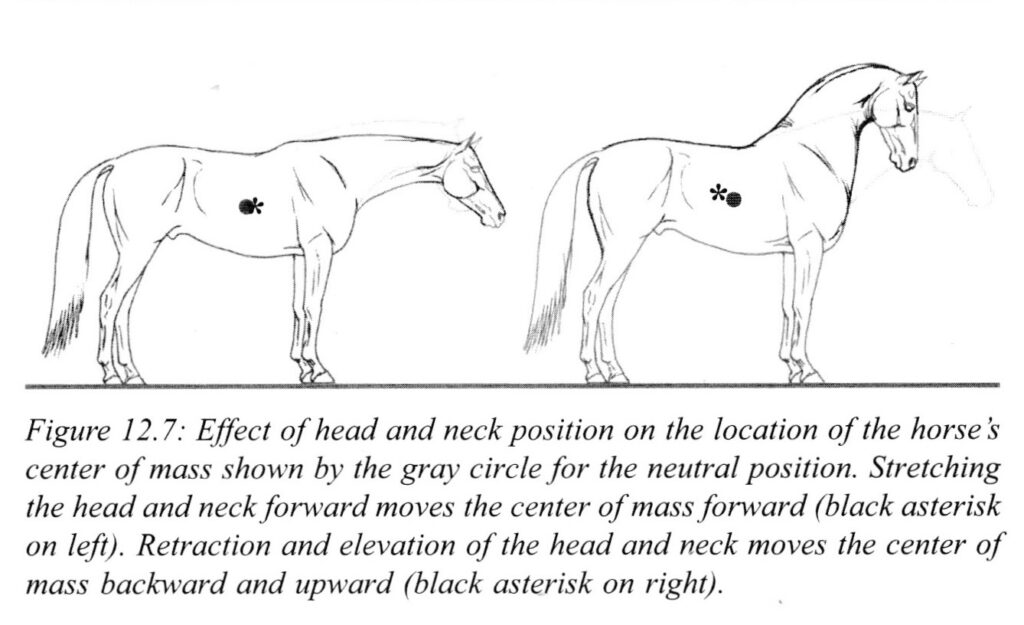
Figure 1.
From The Dynamic Horse by Hilary Clayton, BVMS, PhD, MRCVS. Used with permission from Sport Horse Publications.
At first glance, it might seem this positioning of the neck in a high, strong, reaching arch with the poll at the highest point and the face near vertical has a relatively small effect of a few percentage points on changing the longitudinal balance of the horse or affecting its back to help carry the additional weight of the rider. However, the positioning of the neck is critically important, because the neck is the gatekeeper to connecting the topline of the horse. If the topline can be made into one strongly connected piece, then if the rider can get the horse to start bringing the great muscles of the hind end more under the mass, the rider has the possibility of lightening the forehand, not by a few percentage points, but by an infinite range all the way up to 100% lightening of the forehand, as in the levade.
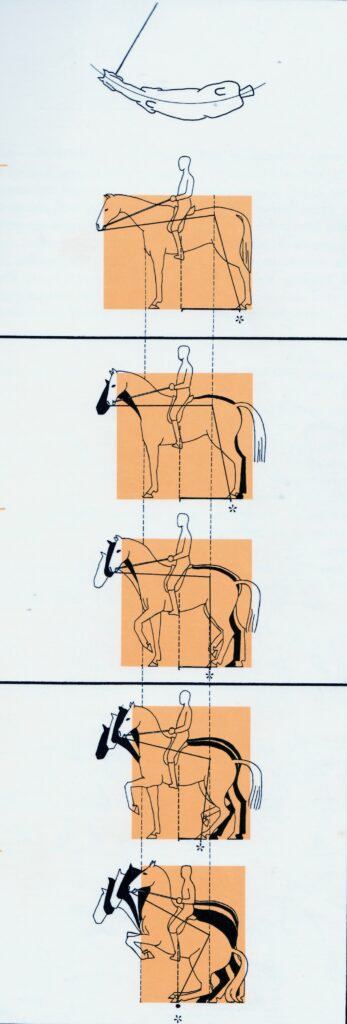
Figure 2.
In this elegant and simple masterpiece of a diagram, we see the classical road map through the phases of collecting the horse, the position of the neck and continuously engaging hindquarters.
Illustration from Hans Handler’s The Spanish Riding School: Four Centuries of Classical Horsemanship
The position of the neck unfortunately has its greatest influence because it can be the “spoiler” to this systematically trained weight shift. If the neck is allowed or trained to be loose and low, it will always be a potential escape for collection, not giving the hind end and back anything to connect with, and add more weight to lift. These horses cannot develop enough core strength for leverage. A pry bar made of rubber is useless.
Imagine you are in the gym and are going to lift a barbell. You step up to the weight, flex your knees and straighten your back, but the trainer rolls the barbell away from you by a foot or so. If you try to lift without fixing your stance, what do you think is going to happen to your lower back, etc? Unlike the feral horse or an unridden horse, the ridden horse must be trained not to use its neck for leverage. The ridden horse must stabilize the neck, taking it out of the balancing equation, and instead use the muscles of the core, back, and hind end to come under the weight. The same way the human needs to be trained to block the instinct of lifting when stretched out, but instead firm and straighten the back, bend the knees and come under the weight. An interesting note can be made here: one of the worst human jobs for back problems and pain is that of a chambermaid, a person who makes beds all day long, often carrying nothing much heavier than a sheet or blanket, but constantly locking the knees and leaning over stretching and lifting, day after day. Even without much weight, this posture is harmful.
Too many dressage riders and organizations seem to be ignoring these simple biomechanics and confusing stretching and strength training. The result is showing up in so much faulty collection; hollow backs, camped out hind ends, squatting behind and not sitting, swaying hind legs, epidemic joint injections. No good human trainer would risk asking an athlete to come up to a barbell with such faulty fundamental stances, and neither should any dressage trainer.
Why has riding the neck down so low and long gained popularity? One reason is that when the neck is ridden down and out there is a lever action, a kind of seesaw with the fulcrum at the withers. When the head and neck goes down in the front of the winters, the back comes up behind the withers under the saddle. HERE LIES THE SEDUCTION. Riders who have never felt or understood real collection, feel this lift and wonder ‘how can it be wrong’? For cooling down or rests of course it is fine, but the unintended consequence is that this riding is further overburdening an already overburdened forehand and lightening the hind end, over time weakening the very muscles needed for collection. And like the leaning chambermaid, stretched out while working, this posture for horses is courting injury, not building strength.
However, there is another fulcrum in the horse’s topline and it is centered at the lumbo-sacral area, with the psoas-iliopsoas group of muscles in particular being responsible for bringing the hind end down and under. This is the fulcrum that classical dressage is most concerned with. In the 1600’s, the Duke of Newcastle said the whole objective of schooling the horse is to get the horse upon the haunches. When the hind end comes down and under, the rider will also feel a lift in the horse’s back, but this time the intended consequence will be the lightening of the forehand, the strengthening of the core, back and hind legs.
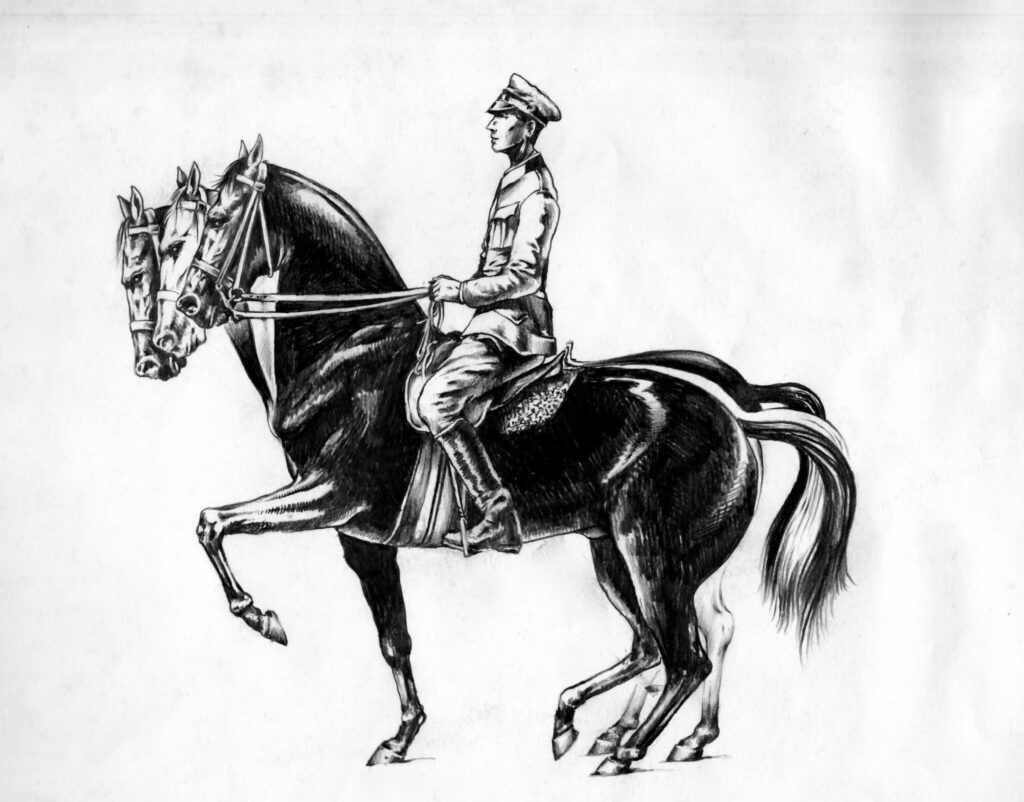
Figure 3. In this system, the horse will ultimately be able to carry the rider in increasing collection. Drawing by Brian Tutlo for Paul Belasik.
Eventually in this system of training, the horse will be able to carry a rider in increasing collection that can ultimately result in piaffe or levade, even if you don’t intend to go quite that far.
The traditional method for starting the dressage horse is by lungeing in side reins without the weight of the rider. (See Paul’s recent article “A Cornerstone of Training a Classical Dressage Horse: The Role of Lungeing with Side Reins” ). The side reins help position the neck either up or down, with more or less bend right or left, while the horse learns to engage the hind end in a series of transitions and changes of bend, all without using the neck as an unridden horse would. Some horses will come to the training with a wonderful sense of balance and will be conformed to use the hind end almost naturally, but for many horses, like people lifting things the wrong way, they will have to be helped. (In a sense, the natural movement of the horse becomes a moot point when you add the unnatural weight of the rider. There must be some ethical preparation.
So now we have an understanding of longitudinal balance, collection. We can engage trainers who are expert to help, we can read and study the classics. We should be on our way, right? Unfortunately, no! Now we will face a beast that has challenged some of the greatest equestrian minds and bodies throughout history. My next article: “A Beast That Can Block All Your Knowledge of Collection.”
Breeding your next dressage star this season in Australia? Select a top European stallion for your mare…
Go to www.ihb.com.au
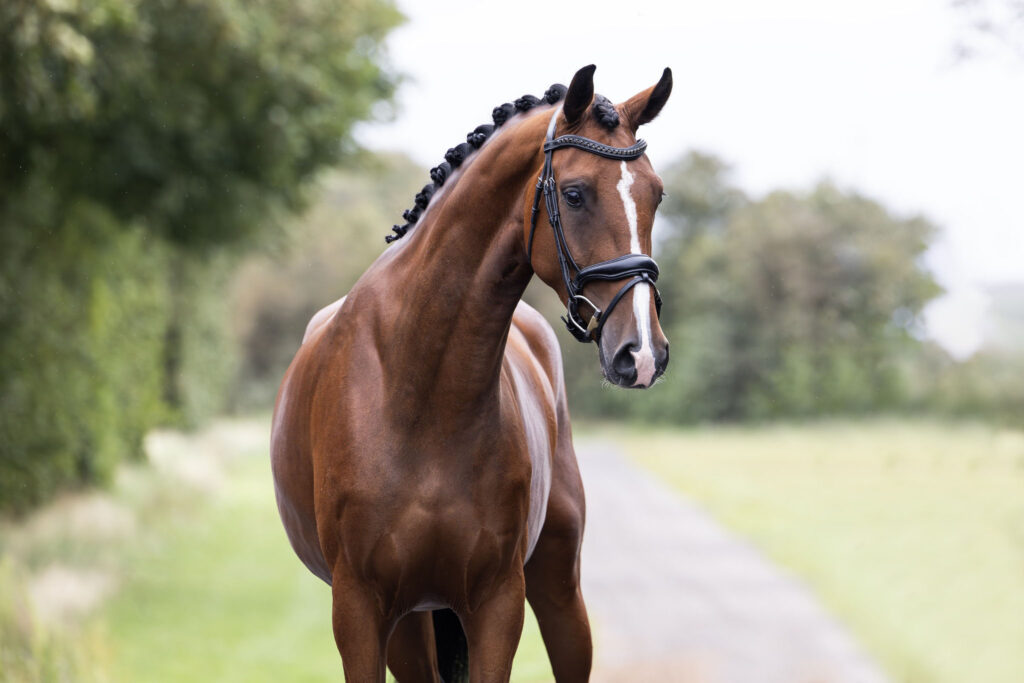
Franklin
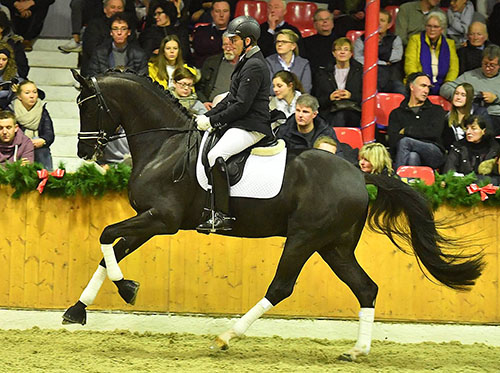
Donier
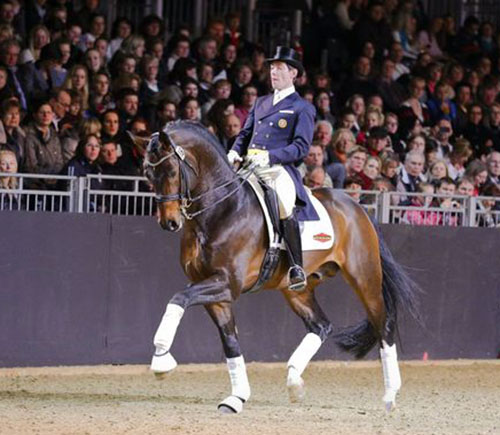 Fidertanz
Fidertanz



Great article! Looking forward to the next one….
🏇🏻
Brilliant article!!!
Learned so much from this article
Thanks Kindly
Wonderful explanation, great article! Looking forward to the next one !
THANKYOU .. so well written
Thank you, something I try to explain over and over to my students that are too tempted by long and low.
Totally wrong forgetting the first steps of training and developing. The horse must go long and low for a long period to develop the back muscles. This frees the hind end and gets it to swing underneath to where the legs can start to support the weight and relieve the front end. You then gradually load the hind end with weight. When the hind end is strong enough through lateral work and transitions, etc. The head and neck are raised not by the rider but the shifting of the weight to the hind end by the horse through systematic gymnastic exercises. Short to long steps to put it bluntly.
This culminates in the piaffe, passage and if wanted the levade
The lack of people riding forward long and low long enough is more a problem for correct equitation today. We need a stronger and longer period building basic foundations. Less shaping and passage trot steps
It’s these words that always worry me in treatises like this, “based on 500 years of experience and evidence”. Surely as the sun rises and the moon is round we must have learnt a thing or two since then, about horse training and welfare too. Granted we may have started, and rather confidently too from the proposition that the moon is round but this doesn’t stop us learning new things in its tracks does it. This is the problem with these statements their impact is minimal, they’re too easily dismissible.
However I shall have to wait to read the second half before plunging on.
Today in any case,we see the horse as an athlete, the complete athlete, one that needs loosening, stretching before and after work, needs building up of muscle and joints. I don’t in any case know of anyone (besides show jumpers) who train exclusively on the forehand nor any in a long and low and round position. And boy do show jumpers use their hind legs and know how to lift their head to prepare for the all mighty leap.
I do however know trainers who school exclusively in competition frame, doesn’t matter how old or young the horse might be, holding the horse together between leg and rein, spur and whip. It’s these youngsters that end up the all too familiar “hollow backed, camped out hind ends, squatting behind” mostly behind the vertical so called Grand Prix horses. They have lost all flexibility, the ability to use their bodies in a gymnastic way, backs permanently crippled with induced lordosis.
If we’re talking roll keur with the term “long and low” here this is a different story and is thus confused itself. A horse may be perfectly balance going long and low, rider in a light seat horse stepping smartly up behind with as much power as anything in collection, possibly much more. Lifting the wither and indeed back. It should be able to do so, trained to do so when asked. This develops and strengthens the top line of young horses. Unfortunately it’s no where to be seen in young horse competitions which are all about front end “movement” alone. Yes, whatever lip service judges make still today. This position of “low and round” can also be seen in a horse at liberty far more than anything collected ever will be. The reason is it sends a message of power and healthy virility. Head lowered to attack, wither up, front and chest up, back up, the whole horse dancing three feet in the air.
Wonderful and informative article. Thank you